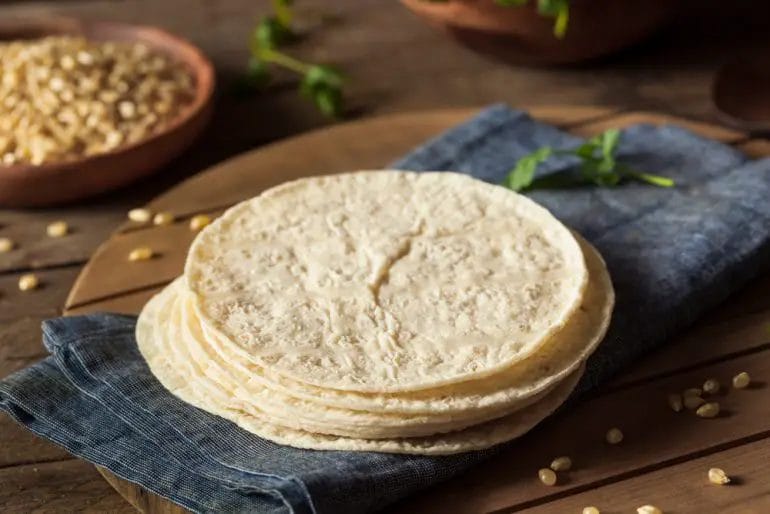Mold on tortillas can appear as fuzzy, discolored patches or spots on the surface. It often has a green, blue, or black color, but can also be white or gray.
The texture of the mold may vary, ranging from soft and fuzzy to powdery. It is important to note that consuming moldy tortillas can be harmful to your health, so it’s essential to discard any tortillas with visible mold.

Common Signs of Mold Growth on Tortillas
Mold growth on tortillas can be a common occurrence, especially when they are not stored properly or kept for an extended period of time. Mold is a type of fungus that thrives in warm and humid conditions, and can easily grow on various food items, including tortillas.
It is important to be able to identify the signs of mold growth on tortillas to ensure that you do not consume contaminated food.
Here are some common signs to look out for:
1. Visible Mold Spots
The most obvious sign of mold growth on tortillas is the presence of visible mold spots. These spots can range in color from green, blue, white, or black. Mold can appear as fuzzy patches or small dots on the surface of the tortilla.
If you notice any discoloration on your tortilla, it is essential to inspect it closely for mold before consuming.
2. Musty Odor
Mold has a distinct musty odor that is easily recognizable. If you detect an unusual smell coming from your tortilla, it may indicate the presence of mold.
This odor is often described as earthy or damp. It is advisable to discard tortillas that emit a strong musty smell.
3. Texture Changes
Mold growth can cause changes in the texture of tortillas. If you notice that your tortilla feels slimy or sticky to the touch, it could indicate the presence of mold.
Mold can also cause the tortilla to become dry or crumbly in some cases. Any noticeable changes in texture should be a cause for concern.
4. Allergenic Reactions
Sometimes, consuming mold-contaminated tortillas can lead to allergic reactions. Symptoms of an allergic reaction may include itching, swelling, redness, or difficulty breathing.
If you experience any of these symptoms after consuming a tortilla, it is important to seek medical attention immediately.
5. Expiration Date
Checking the expiration date is crucial to ensure the freshness and safety of tortillas. Even if there are no visible signs of mold, consuming expired tortillas can still pose health risks.
Mold growth may not always be visible, especially in its early stages. Discard tortillas that have passed their expiration date to avoid any potential health issues.
Being able to identify the common signs of mold growth on tortillas is essential for maintaining food safety. Always visually inspect tortillas for any visible mold spots, pay attention to any musty odors, and check for texture changes. It is important to discard any tortillas that show signs of mold or have expired. By staying vigilant and ensuring proper storage and handling of tortillas, you can avoid consuming mold-contaminated food and protect your health.

How to Recognize Mold on Tortillas: A Step-by-Step Guide
Like any other food item, tortillas can be susceptible to mold growth. Mold on tortillas not only affects their taste and texture but can also pose health risks. Therefore, it is important to know how to recognize mold on tortillas to ensure food safety.
In this guide, we will take you through the step-by-step process of identifying mold on tortillas.
Step 1: Inspection
The first step in recognizing mold on tortillas is to visually inspect them. Look for any visible signs of mold, which can appear as patches or spots of fuzzy or discolored growth.
Mold can be different colors, including white, green, blue, black, or even pink.
Step 2: Smell Test
Next, use your sense of smell to detect any musty or off-putting odors. Mold-infested tortillas often emit a distinct and unpleasant smell.
If the tortillas have an unusual odor, it could be an indication of mold growth.
Step 3: Texture Check
Another way to recognize mold on tortillas is through their texture. Mold can cause tortillas to become slimy, sticky, or develop an unusual texture.
Gently touch the tortillas to check for any abnormalities in texture.
Step 4: Expiration Date
Always check the expiration date on the tortilla packaging. Mold growth is more likely to occur on expired or improperly stored tortillas.
If the tortillas are past their expiration date, it’s best to discard them to avoid any potential health risks.
Step 5: Hidden Mold
While visible mold is easy to spot, it’s important to be aware of hidden mold as well. Inspect the tortillas thoroughly, including the edges, folds, and underneath the packaging.
Mold can sometimes grow in hidden areas, so make sure to check the tortillas from all angles. We recommend checking inside of the tortillas before eating as well.
Step 6: Packaging Condition
Pay attention to the condition of the tortilla packaging. Damaged or compromised packaging can allow moisture and air to enter, creating an ideal environment for mold growth.
If the packaging is torn, pierced, or shows signs of damage, it’s best to discard the tortillas.
Step 7: Mold Remediation
If you discover mold on tortillas, it’s crucial to handle it properly to prevent further contamination.
Dispose of any mold-infested tortillas immediately and ensure that they are sealed in a plastic bag before throwing them away.
Clean the area where the mold-contaminated tortillas were stored to eliminate any remaining spores.
Recognizing mold on tortillas involves visual inspection, smell test, texture check, checking the expiration date and packaging condition, and being aware of hidden mold. By following these steps, you can ensure that the tortillas you consume are safe and free from mold contamination.

4. Mold Colors and Patterns on Tortillas: What to Look For
In this section, we will discuss the different mold colors and patterns that can appear on tortillas, and what they indicate.
Mold Colors
Mold on tortillas can appear in various colors, ranging from white to green, blue, or even black. Each color indicates a different type of mold, with varying levels of danger. Here are the common mold colors that you may come across on tortillas:
- White Mold: White mold is the most common type found on tortillas. It typically appears as fuzzy patches or spots. While white mold can be harmless, it is best to discard tortillas with extensive white mold growth as it may indicate the presence of other molds.
- Green Mold: Green mold is another common type that can grow on tortillas. It usually appears as greenish patches or fuzz. Green mold can produce toxins and should be avoided.
- Blue Mold: Blue mold is less common but can still occur on tortillas. It often appears as bluish-green patches. Blue mold can produce mycotoxins, which can be harmful if consumed in large quantities.
- Black Mold: Black mold is the most concerning type, as it can produce mycotoxins and pose serious health risks. It typically appears as black or dark green patches. If you notice black mold on tortillas, it is best to discard them immediately.
Mold Patterns
In addition to different colors, mold on tortillas can also form different patterns. These patterns can provide clues about the type of mold and how it may have developed. Here are some common mold patterns that you may encounter:
- Spotting: Mold spotting is characterized by small, individual spots scattered across the tortilla’s surface. This pattern can be seen with various mold colors and is typically an indication of early mold growth.
- Clustering: Mold clustering occurs when multiple spots or patches of mold merge together, forming larger clusters. This pattern often indicates more advanced mold growth and may suggest prolonged exposure to moisture.
- Veining: Mold veining refers to the development of thin, thread-like lines across the tortilla’s surface. This pattern is commonly associated with certain types of mold, such as blue mold, and can indicate a more aggressive growth.
- Powdery Coating: Some molds may form a powdery coating on the tortilla’s surface. This can give the tortilla a dusty appearance and is often an indication of advanced mold growth.
It’s important to note that while mold colors and patterns can provide valuable information, it is always safest to assume that any visible mold on tortillas indicates potential contamination. If you encounter mold on your tortillas, it is best to discard them to avoid any health risks.
Understanding the Importance of Properly Handling Moldy Tortillas
Moldy tortillas can be a common issue in households or food establishments, and it is crucial to handle them properly to prevent any health risks or food waste.
Mold is a type of fungus that can grow on various food items, including tortillas, when they are exposed to moisture and improper storage conditions.
In this section, we will explore the significance of recognizing and addressing moldy tortillas promptly.
1. Health Risks
Mold growth on tortillas can pose significant health risks, particularly for individuals with respiratory conditions, allergies, or weakened immune systems.
Certain types of mold produce mycotoxins, which can lead to allergic reactions, respiratory issues, and even toxic effects when ingested in large amounts. Consuming mold-contaminated tortillas can cause symptoms such as nausea, vomiting, diarrhea, and abdominal pain.
Therefore, it is essential to handle moldy tortillas with caution to prevent any potential health complications for yourself or others who may consume them.
2. Food Safety
Properly handling moldy tortillas is crucial to maintain food safety standards. Mold can grow rapidly and spread to other food items if not handled correctly.
If moldy tortillas come into contact with other non-contaminated food, it can lead to cross-contamination, potentially causing the growth of mold on other items as well.
Furthermore, mold growth on tortillas can be an indicator of improper storage or moisture issues in the surrounding environment. Addressing the issue promptly and ensuring proper food storage practices can help prevent the spread of mold and maintain overall food safety.
3. Preventing Food Waste
Proper handling of moldy tortillas can also help reduce food waste. Moldy tortillas should never be consumed, as they can pose health risks as mentioned earlier.
However, it is important to note that not all molds are visible to the naked eye. Therefore, if you come across even a single moldy tortilla, it is advisable to discard the entire batch to prevent the potential ingestion of invisible molds.
By promptly identifying and discarding moldy tortillas, you can prevent the spread of mold to other tortillas and minimize food wastage in your household or food establishment.
What does mold on tortillas look like?
Mold on tortillas appears as discolored spots, usually green, white, or black. It may also have a fuzzy or powdery texture. If you see any mold on your tortillas, it is best to discard them to avoid potential health risks.
Conclusion:
Understanding what mold on tortillas looks like is crucial for ensuring food safety. Mold on tortillas appears as fuzzy or powdery patches that can range in color from white or green to black.
It is essential to inspect tortillas thoroughly before consumption to identify any signs of mold growth. If mold is present, it is best to discard the entire package to prevent the risk of foodborne illnesses.
Always store tortillas in a cool and dry place to minimize the likelihood of mold formation. Remember, maintaining proper food hygiene practices is key to enjoying safe and delicious tortillas.

